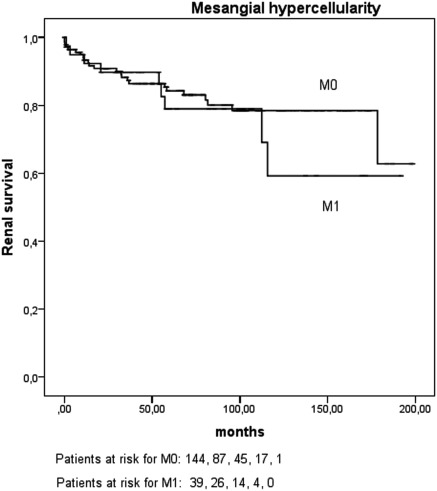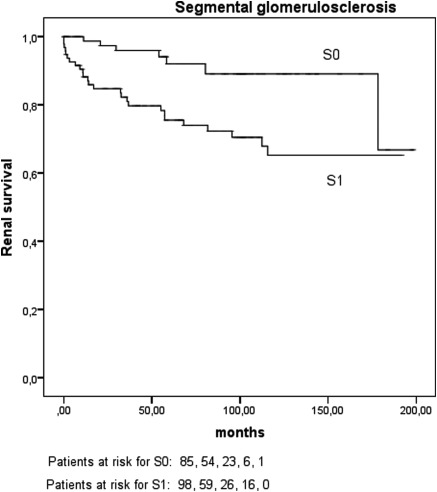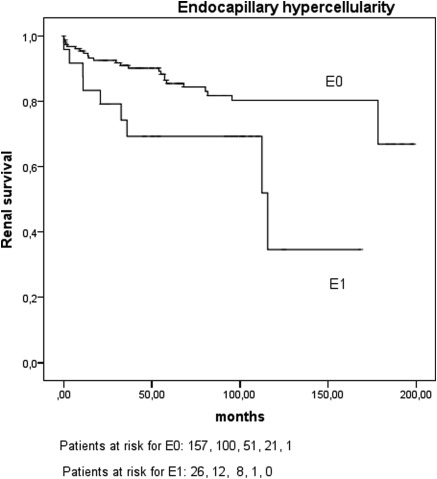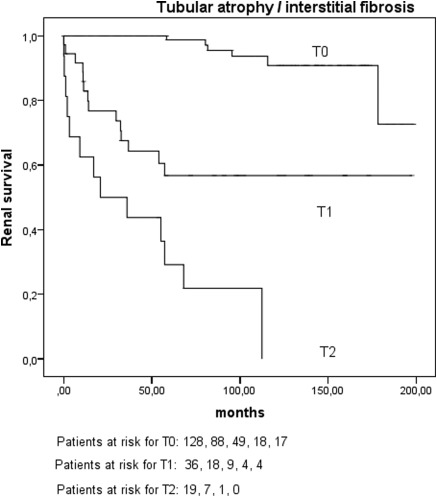Abstract
Summary
Background and objectives
A new classification for IgA nephropathy was recently proposed, namely the Oxford classification. It established specific pathologic features that predict the risk of progression of renal disease. This classification needs validation in different patient populations. We propose a retrospective study to evaluate the predictive value of the Oxford classification on renal survival defined by doubling creatinine or end-stage renal disease in patients with IgA nephropathy.
Design, setting, participants, & measurements
We included 183 patients with primary IgA nephropathy diagnosed between 1994 and 2005. Mean follow-up time was 77 months. Doubling creatinine occurred in 20% of the patients, and end-stage renal disease occurred in 16%. The biopsies were revisited to apply the Oxford classification. The influence of pathologic features on renal survival was analyzed in univariate and multivariate models.
Results
In univariate time-dependent analyses, tubular atrophy/interstitial fibrosis, segmental glomerulosclerosis, and endocapillary hypercellularity strongly impacted doubling creatinine or end-stage renal disease. On the contrary, mesangial hypercellularity was not associated with renal outcome. In the multivariate model, only estimated GFR at baseline was a risk factor, pathologic lesions having no independent influence.
Conclusions
We confirm the usefulness of the Oxford classification to establish the renal prognosis of patients with IgA nephropathy, although renal function at baseline seems to be of a greater importance than pathologic lesions.
Introduction
IgA nephropathy is associated with a 15% occurrence of end-stage renal failure within 10 years (1). Estimation of the prognosis was mainly based on clinical criteria. It is noteworthy that few randomized therapeutic trials included pathologic factors as inclusion criteria (2). Many classifications had been proposed over the years, on the basis of either classes or semiquantitative scores (3–10). These in-house classifications were mostly in use in single centers, making comparisons, at best, difficult. The International IgA Nephropathy Network started in 2004 to develop a consensus clinicopathologic classification of IgA nephropathy. Two publications in 2009 by Cattran et al. (11) and Roberts et al. (12) explained and proposed the Oxford classification of IgA nephropathy. This classification was intended to be easily reproducible, to avoid redundancy in useful pathologic features, and to have independent value in predicting clinical outcome. The classification and its conclusions were established from a cohort of 206 adults and 59 children gathered from four continents. This classification is rapidly gaining popularity, but its clinical application deserves to be validated in different populations (13,14). We created a single-center retrospective study to evaluate the predictive value of the Oxford classification on renal survival.
Study Population and Methods
Patient Selection
All of the patients at our institution with a pathologic diagnosis or primary IgA nephropathy were primarily considered for selection. The inclusion period spanned from 1994 to 2005. Very mild and very severe forms of the disease were not excluded a priori.
Exclusion Criteria
We did not include the patients who met one of these criteria: insufficient clinical data; poor conservation of the pathologic material, which could jeopardize the interpretation; and less than eight glomeruli on the biopsy. We took care not to include the 23 patients of our center who had been previously picked at random to be included in the Oxford study.
Pathologic and Clinical Data
All of the biopsies were independently revisited by one pathologist and one trained nephrologist, who applied the Oxford classification and made a second reading in case of discrepancy. The lesions comprised mesangial hypercellularity (M0 or M1), segmental glomerulosclerosis (S0 or S1), endocapillary hypercellularity (E0 or E1), and tubular atrophy/interstitial fibrosis (T0, T1, or T2). M1 was defined by the presence of more than three cells in the most cellular mesangial area, but not adjacent to the vascular stalk, on more than 50% of the glomeruli. S1 was defined by the presence of tuft adhesion and segmental sclerosis but not global sclerosis. E1 was defined by the presence of an increased number of cells within capillary lumina causing narrowing. The percentage of cortical area damaged by interstitial fibrosis of tubular atrophy defined T1 (26 to 50%) or T2 (>50%). The following data were gathered at the time of biopsy: age, gender, amount of proteinuria, presence of an arterial hypertension (arterial BP >140/90 mmHg or specific treatment), serum creatinine, estimated GFR (altered Modification of Diet in Renal Disease), and Kidney Disease Outcomes Quality Initiative stage. At last follow-up we recorded duration of follow-up, amount of proteinuria, presence of an arterial hypertension, serum creatinine, estimated GFR (eGFR), Kidney Disease Outcomes Quality Initiative stage, and any treatment with renin angiotensin system blockers or steroids.
Study End Point
Renal survival was the end point of our study. We considered both doubling of serum creatinine and end-stage renal failure, defined by stage 5 chronic kidney disease.
Statistical Analyses
The occurrence of doubling of serum creatinine or of end-stage renal disease was analyzed with the Kaplan–Meier method, using the time of renal biopsy as the starting point and logrank test for comparisons. For multivariate analyses, we used the Cox regression model. Variables that were included in the model were the amount of proteinuria, the presence of arterial hypertension, eGFR at time of renal biopsy, and the individual MSET lesions. Statistics were done with IBM SPSS 19.
Results
For the 1994 to 2005 period, 294 renal biopsies of primary IgA patients were recorded in our files. Exclusion criteria dropped out 111 patients. The main reason was the presence of less than eight glomeruli on biopsy samples. The study population included 183 patients, 137 men and 46 women, with average ages of 38 ± 16 years at the onset of the disease and 43 ± 16 years at time of the biopsy. Arterial hypertension was present in 70 patients, mean proteinuria was 1.24 ± 1.49 g/24 h, and mean eGFR was 72 ± 32 ml/min per 1.73 m2. Estimated GFR was less than 30 ml/min per 1.73 m2 in 25 patients (13.6%). Mean follow-up time was 77 ± 54 months (median, 68 months). As compared with the beginning, more patients became hypertensive (50%), mean eGFR was 62 ± 33 ml/min per 1.73 m2, proteinuria was diminished (0.90 ± 1.20 g/d), but 65% of the patients were treated with renin angiotensin system blockers. Steroids had been given to a third of the patients. Doubling of creatinine was observed in 36 patients (20% of the study population). Among these 36 patients, end-stage renal disease was reached by 30 patients (16%), all of whom eventually required dialysis or transplantation (Table 1).
Table 1.
Clinical characteristic at the time of biopsy and last follow-up
| Variables | No Doubling Serum Creatinine or ESRD (n = 147) | Doubling Serum Creatinine or ESRD (n = 36) | P |
|---|---|---|---|
| Age at biopsy (years) | 40 ± 15 | 57 ± 15 | <0.001 |
| Proteinuria at biopsy (g/d) | 0.89 ± 1.18 | 2.79 ± 1.77 | <0.001 |
| Proteinuria at biopsy (<1, 1 to 3, >3 g/d) | 102, 36, 9 | 9, 12, 15 | <0.001 |
| Hypertension at biopsy | 30% | 71% | <0.001 |
| eGFR at biopsy (ml/min per 1.73 m2) | 82 ± 25 | 31 ± 24 | <0.001 |
| CKD stage at biopsy (1, 2, 3, 4, 5) | 54, 63, 26, 4, 0 | 1, 3, 11, 9, 12 | <0.001 |
| Follow-up duration (months) | 83 ± 53 | 39 ± 42 | <0.001 |
| eGFR at last follow-up (ml/min per 1.73 m2) | 74 ± 24 | 10 ± 9 | <0.001 |
| RAS blockade | 48% | 56% | 0.04 |
| Steroids | 13% | 32% | 0.004 |
The data are expressed as means ± SD, numbers, or percentages. eGFR was calculated using altered Modification of Diet in Renal Disease. eGFR, estimated GFR; RAS, renin angiotensin system.
The repartition of the MSET lesions was as follows. Mesangial hypercellularity was present in 21%, segmental glomerulosclerosis was present in 54%, endocapillary hypercellularity was present in 14%, and tubular atrophy/interstitial fibrosis was present in 30%. Only six patients (5%) had crescents, which involved less than 15% of their glomeruli (Table 2).
Table 2.
Frequency of pathological features in 183 biopsies
| Mesangial Hypercellularity | Segmental Glomerulosclerosis | Endocapillary Hypercellularity | Tubular Atrophy Interstitial Fibrosis | |
|---|---|---|---|---|
| 0 | 144 (79%) | 85 (46%) | 157 (86%) | 128 (70%) |
| 1 | 39 (21%) | 98 (54%) | 26 (14%) | 36 (20%) |
| 2 | 19 (10%) |
The data are expressed as numbers (percentages).
In univariate time-dependent analyses, regarding the end point of doubling creatinine or end-stage renal disease, tubular atrophy/interstitial fibrosis (P < 0.001), segmental glomerulosclerosis (P = 0.003), and endocapillary hypercellularity (P = 0.007) strongly impaired renal survival. On the contrary, mesangial hypercellularity was not significantly associated with renal outcome (Figures 1–4). In the Cox regression model, the only significant variable was eGFR at time of biopsy. Neither proteinuria, arterial hypertension, nor the MSET lesions were significant variables (Table 3). Stratification on initial eGFR did not change this result. The multivariate analysis was also done with just the histologic variables. In this model, tubular atrophy/interstitial fibrosis was significantly associated with the renal outcome (Table 3).
Figure 1.
Renal survival according to mesangial hypercellularity (M0 or M1), P = 0.51.
Figure 2.
Renal survival according to segmental glomerulosclerosis (S0 or S1), P = 0.003.
Figure 3.
Renal survival according to endocapillary hypercellularity (E0 or E1), P = 0.007.
Figure 4.
Renal survival according to tubular atrophy/interstitial fibrosis (T0, T1, or T2), P < 0.001.
Table 3.
Cox multivariate model for renal survival with (panel A) and without (panel B) clinical parameters
| Variables | Values | Exp β | 95% CI | P | |
|---|---|---|---|---|---|
| A | Proteinuria | g/d | 0.93 | 0.71 to 1.21 | 0.59 |
| Hypertension | 0/1 | 1.05 | 0.41 to 2.70 | 0.89 | |
| eGFR | 10 ml/min | 0.50 | 0.38 to 0.65 | <0.01 | |
| M | 0/1 | 1.06 | 0.43 to 2.63 | 0.88 | |
| S | 0/1 | 1.81 | 0.61 to 5.35 | 0.27 | |
| E | 0/1 | 1.66 | 0.60 to 5.35 | 0.32 | |
| T | 0/1/2 | 1.24 | 0.61 to 2.53 | 0.55 | |
| B | M | 0/1 | 0.63 | 0.27 to 1.43 | 0.27 |
| S | 0/1 | 1.89 | 0.78 to 4.54 | 0.15 | |
| E | 0/1 | 1.59 | 0.71 to 3.56 | 0.25 | |
| T | 0/1/2 | 5.11 | 3.16 to 8.28 | <0.01 |
M, mesangial hypercellularity; S, segmental glomerulosclerosis; E, endocapillary hypercellularity; T, tubular atrophy/interstitial fibrosis; CI, confidence interval; eGFR, estimated GFR; exp β, hazard ratios.
We also tested the impact of MSET lesions on the event of end-stage renal disease. We found the same influence of tubular atrophy/interstitial fibrosis (P < 0.001), segmental glomerulosclerosis (P = 0.002), and endocapillary hypercellularity (P = 0.005) but not of mesangial hypercellularity (P = 0.59). In the Cox model, initial eGFR was again the only significant parameter. The same analyses were done after having dropped out the 12 patients who presented with stage 5 CKD at time of biopsy. The results were not different, although statistical significance was lessened.
Clinicopathological correlations were analyzed at the time of biopsy (Table 4). All of the lesions but mesangial hypercellularity were associated with higher amount of proteinuria and lower eGFR. Arterial hypertension was more frequent in patients with segmental glomerulosclerosis and tubular atrophy/interstitial fibrosis. Treatment with high doses of steroids had been given to 56% of the patients with M1 score (26% if M0, P < 0.001), 53% of the patients with T1 or T2 score (24% if T0, P < 0.001), 48% of the patients with S1 score (15% if S0, P < 0.001), and 42% of the patients with E1 score (31% if E0, P = 0.27).
Table 4.
Clinicopathological correlations at time of renal biopsy
| Proteinuria | P | Hypertension | P | eGFR | P | |
|---|---|---|---|---|---|---|
| Mesangial hypercellularity | ||||||
| M0 | 1.15 ± 1.45 | 39 | 72 ± 32 | |||
| M1 | 1.56 ± 1.61 | 0.64 | 33 | 0.57 | 70 ± 39 | 0.89 |
| Segmental glomerulosclerosis | ||||||
| S0 | 0.50 ± 0.81 | 26 | 83 ± 28 | |||
| S1 | 1.89 ± 1.65 | 0.001 | 49 | 0.003 | 62 ± 32 | 0.001 |
| Endocapillary hypercellularity | ||||||
| E0 | 1.44 ± 1.40 | 39 | 74 ± 31 | |||
| E1 | 1.85 ± 1.91 | 0.003 | 35 | 0.82 | 56 ± 35 | 0.007 |
| Tubular atrophy/interstitial fibrosis | ||||||
| T0 | 0.72 ± 0.90 | 29 | 86 ± 22 | |||
| T1 | 2.01 ± 1.61 | 47 | 44 ± 25 | |||
| T2 | 3.55 ± 1.96 | 0.001 | 84 | 0.001 | 26 ± 23 | 0.001 |
The data are expressed as means ± SD or percentages. eGFR, estimated GFR.
Discussion
The ideal validation of the Oxford classification should be a prospective evaluation in an independent population (14). Unfortunately, such a prospective study will take a long time to reach any conclusion, knowing the slow progression rate of IgA nephropathy. In this retrospective study, we tried to establish the usefulness of the Oxford classification of IgA nephropathy in a new population. Our patients were like those of the Oxford study. We noticed a similar percentage of men (75% versus 72%), a similar percentage of hypertensive patients (38% versus 31%), and a roughly similar amount of proteinuria (1.24 versus 1.7 g/d). Mean eGFR was lower in our study (72 versus 83 ml/min per 1.73 m2). Mean age was slightly higher (43 versus 30 years), but we did not include many pediatric patients. We included 43 patients with eGFR less than 30 ml/min, who were excluded from the Oxford study. A post hoc analysis without these severe patients did not change the global result. Steroids were used in the same proportion of patients (31% versus 29%). The severity of the disease was comparable, because the percentages of patients with doubling creatinine or with end-stage renal failure was the same, with the restriction that our observation period was slightly longer (77 versus 69 months). Lastly, we studied the same composite end point with doubling creatinine or end-stage renal disease but not the rate of renal function decline.
We found tubular atrophy/interstitial fibrosis to have the strongest influence on renal survival. Segmental glomerulosclerosis and endocapillary hypercellularity also worsened the renal outcome. The only lesion that was not associated with renal survival was mesangial hypercellularity. It is important to note that patients in the Oxford study presented with more frequent mesangial hypercellularity and endocapillary hypercellularity than ours. If three of the four proposed pathologic lesions were associated with a worse renal outcome, either doubling creatinine or end-stage renal failure, renal function at baseline was the unique significant variable in the multivariate analysis. Therefore, this study is not able to confirm the independent value of pathologic lesions in regard to renal survival, which was a critical and unique result of the Oxford study.
The Oxford classification included endocapillary hypercellularity, which seemed associated with the use and response to steroids. In our experience, endocapillary hypercellularity was actually the lesion that was the least frequently associated with steroid treatment. The Oxford classification will raise concerns (15), and several validations would be welcome. Other similar studies have been presented at the American Society of Nephrology's Renal Week 2010. A retrospective study from Chicago in 72 patients (16) and one from Korea in 181 patients (17) came to the conclusion that only tubulointerstitial fibrosis was predictive of outcome. Another study from Japan (18) emphasized on the importance of crescents, which were probably excluded from the Oxford study. Crescents were also a rare feature in our study. To avoid any false hope on this classification, one should remember that the importance of tubulointerstitial lesions in the long-term prognosis of IgA nephropathy has been known for a long time (19).
In summary, we applied the Oxford classification in a new population of 183 patients with primary IgA nephropathy with a mean follow-up duration of 6 years. Regarding doubling creatinine or end-stage renal disease, tubular atrophy/interstitial fibrosis was the most powerful lesion, before segmental glomerulosclerosis and endocapillary hypercellularity. However, mesangial hypercellularity did not influence renal survival. None of the pathologic lesions was significant in the multivariate analysis, whereas renal function at baseline was the strongest variable. This constitutes the major difference between this study and the Oxford study.
Disclosures
None.
Footnotes
Published online ahead of print. Publication date available at www.cjasn.org.
Access to UpToDate online is available for additional clinical information at www.cjasn.org.
See related editorial, “Validating the Oxford Classification of IgA Nephropathy,” on pages 2335–2336.
References
- 1. D'Amico G: Natural history of idiopathic IgA nephropathy: Role of clinical and histological prognostic factors. Am J Kidney Dis 36: 227–237, 2000 [DOI] [PubMed] [Google Scholar]
- 2. Laville M, Alamartine E: Treatment options for IgA nephropathy in adults: A proposal for evidence-based strategy. Nephrol Dial Transplant 19: 1947–1951, 2004 [DOI] [PubMed] [Google Scholar]
- 3. Alamartine E, Sabatier JC, Berthoux FC: Comparison of pathological lesions on repeated renal biopsies in 73 patients with primary IgA glomerulonephritis: Value of quantitative scoring and approach to final prognosis. Clin Nephrol 34: 45–51, 1990 [PubMed] [Google Scholar]
- 4. Radford MG, Jr, Donadio JV, Jr, Bergstralh EJ, Grande JP: Predicting renal outcome in IgA nephropathy. J Am Soc Nephrol 8: 199–207, 1997 [DOI] [PubMed] [Google Scholar]
- 5. Katafuchi R, Kiyoshi Y, Oh Y, Uesugi N, Ikeda K, Yanase T, Fujimi S: Glomerular score as a prognosticator in IgA nephropathy: Its usefulness and limitation. Clin Nephrol 49: 1–8, 1998 [PubMed] [Google Scholar]
- 6. Lee SM, Rao VM, Franklin WA, Schiffer MS, Aronson AJ, Spargo BH, Katz AI: IgA nephropathy: Morphologic predictors of progressive renal disease. Hum Pathol 13: 314–322, 1982 [DOI] [PubMed] [Google Scholar]
- 7. Haas M: Histologic subclassification of IgA nephropathy: A clinicopathologic study of 244 cases. Am J Kidney Dis 29: 829–842, 1997 [DOI] [PubMed] [Google Scholar]
- 8. Wakai K, Kawamura T, Endoh M, Kojima M, Tomino Y, Tamakoshi A, Ohno Y, Inaba Y, Sakai H: A scoring system to predict renal outcome in IgA nephropathy: From a nationwide prospective study. Nephrol Dial Transplant 21: 2800–2808, 2006 [DOI] [PubMed] [Google Scholar]
- 9. Manno C, Strippoli GF, D'Altri C, Torres D, Rossini M, Schena FP: A novel simpler histological classification for renal survival in IgA nephropathy: A retrospective study. Am J Kidney Dis 49: 763–775, 2007 [DOI] [PubMed] [Google Scholar]
- 10. Goto M, Wakai K, Kawamura T, Ando M, Endoh M, Tomino Y: A scoring system to predict renal outcome in IgA nephropathy: A nationwide 10-year prospective cohort study. Nephrol Dial Transplant 24: 3068–3074, 2009 [DOI] [PMC free article] [PubMed] [Google Scholar]
- 11. Cattran DC, Coppo R, Cook HT, Feehally J, Roberts IS, Troyanov S, Alpers CE, Amore A, Barratt J, Berthoux F, Bonsib S, Bruijn JA, D'Agati V, D'Amico G, Emancipator S, Emma F, Ferrario F, Fervenza FC, Florquin S, Fogo A, Geddes CC, Groene HJ, Haas M, Herzenberg AM, Hill PA, Hogg RJ, Hsu SI, Jennette JC, Joh K, Julian BA, Kawamura T, Lai FM, Leung CB, Li LS, Li PK, Liu ZH, Mackinnon B, Mezzano S, Schena FP, Tomino Y, Walker PD, Wang H, Weening JJ, Yoshikawa N, Zhang H: The Oxford classification of IgA nephropathy: Rationale, clinicopathological correlations, and classification. Kidney Int 76: 534–545, 2009 [DOI] [PubMed] [Google Scholar]
- 12. Roberts IS, Cook HT, Troyanov S, Alpers CE, Amore A, Barratt J, Berthoux F, Bonsib S, Bruijn JA, Cattran DC, Coppo R, D'Agati V, D'Amico G, Emancipator S, Emma F, Feehally J, Ferrario F, Fervenza FC, Florquin S, Fogo A, Geddes CC, Groene HJ, Haas M, Herzenberg AM, Hill PA, Hogg RJ, Hsu SI, Jennette JC, Joh K, Julian BA, Kawamura T, Lai FM, Li LS, Li PK, Liu ZH, Mackinnon B, Mezzano S, Schena FP, Tomino Y, Walker PD, Wang H, Weening JJ, Yoshikawa N, Zhang H: The Oxford classification of IgA nephropathy: Pathology definitions, correlations, and reproducibility. Kidney Int 76: 546–556, 2009 [DOI] [PubMed] [Google Scholar]
- 13. Yamamoto R, Imai E: A novel classification for IgA nephropathy. Kidney Int 76: 477–480, 2009 [DOI] [PubMed] [Google Scholar]
- 14. Eitner F, Floege J: Glomerular disease: The Oxford classification. Predicting progression of IgAN. Nat Rev Nephrol 5: 557–559, 2009 [DOI] [PubMed] [Google Scholar]
- 15. Mubarak M: Nomenclature of the Oxford classification of IgA nephropathy: Do we need to be careful? Kidney Int 77: 74; author reply 74–5, 2010 [DOI] [PubMed] [Google Scholar]
- 16. Yau T, Korbet S, Schwartz M, Cimbaluk D: Use of the Oxford classification of IgA nephropathy to predict renal outcome: A retrospective analysis [F-PO1335]. American Society of Nephrology, Renal Week 2010 [DOI] [PubMed] [Google Scholar]
- 17. Lee Y, Lee S, SG. K, Yoon J-W, Koo J-R, Noh J-W, Shin M, Nam E, Oh J: The Oxford IgA nephropathy classification predicting 1-year renal outcome [SA-PO2304]. American Society of Nephrology, Renal Week 2010 [Google Scholar]
- 18. Katafuchi R, Ninomiya T, Mitsuiki K, Nagata M, Hirakata H: The validation study of Oxford classification: The significance of crescent [SA-PO2277]. American Society of Nephrology, Renal Week 2010 [DOI] [PMC free article] [PubMed] [Google Scholar]
- 19. Schena FP: A retrospective analysis of the natural history of primary IgA nephropathy worldwide: Am J Med 89: 209–215, 1990 [DOI] [PubMed] [Google Scholar]






